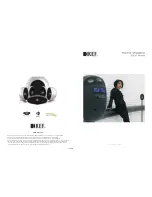
Page 48/82
NEXO
A
NALOGUE
PSTD
C
ONTROLLERS
Low Z
1
2
3
Low Z
1
2
3
TDcontroller
Amplifier
Mixing Desk
1
2
3
1
2
3
+
-
+
-
+
-
+
-
Low Z
L
o
w Z
PE
PE
PE
Safety
Ground
SHIELD
SHIELD
IN
OUT
CAUTION!
This servicing instruction is for use by qualified service personnel only. To reduce the
risk of electric shock, do not perform any servicing other than that contained in the
operating instructions unless you are qualified to do so.
8.3.5 Recommendations for wiring the sense lines
The impedance of the sense inputs of the TDcontroller are high, so currents are low and therefore light
duty cable can be used. If the TDcontroller is housed in the amplifier racks an unshielded cable may be
used.
If the TDcontroller is located remotely - at the mixing position - a shielded cable is recommended,
without using the shield as a conductor. The cable must be well protected from public access, as it
carries potentially dangerous amplifier voltage.
When one of the channels is not being used and the corresponding sense line is disconnected, cross
talk onto the inactive sense line may in some cases produce signals capable of causing the inadvertent
illumination of the Sense LED on that channel; although this has no effect on the internal operation of
the TDcontroller, it can be cured by short-circuiting the terminals of the inactive sense line.
8.3.6 Recommendations for wiring the audio outputs
The output stages can drive several amplifiers in parallel; however it is not advisable to work with loads
of less than 1kOhm(and strictly forbidden to drive less than 600Ohms
)
. It is best to check the
impedance characteristics of the amplifier inputs - supplied by the manufacturer - to check how many
amplifier channels can be paralleled. Where precise information is not available (and taking 10kOhm as
the minimum value possible), ten channels in parallel per output is a sensible maximum.
8.3.7 Electromagnetic
environments
The emission (this word describes all types of electromagnetic noise radiated by the equipment)
requirements which have been applied to Nexo’s TDcontrollers are the stringent requirements of the
”Commercial and light industrial environment” of the product family EMC standard for emission.
The immunity (this word describes the ability to cope with electromagnetic disturbance generated by
other items and natural phenomena) requirements that we have considered exceed those applicable to
the ”Commercial and light industrial environment” of the product family EMC standard for immunity. In
order to provide a further safety margin, we recommend that you do not operate the TDcontrollers in the
presence of electromagnetic interference exceeding half of the limits found in this standard.
These two EMC standards are those
applicable to pro-audio equipment for the
implementation of the ”EMC directive”.
8.3.8 Analogue signal cables
Analogue signals should be connected to the
input and output ports of the TDcontroller via
shielded twisted pair or starquad cable fitted
with XLR connectors on the TDcontroller side.
We recommend the use of low transfer
impedance cables with a braided shield and a
transfer impedance below 10 m
Ω
/m. For the
sense inputs, the noise requirements are not
as stringent, and any kind of twisted pair cable
will be adequate.
The TDcontroller is intended to be used with
symmetrical (balanced) sources (for instance a mixer) and symmetrical loads (for instance a power
amplifier (see figure). You can see that the TDcontroller provides a low impedance path between pin 1
of its XLR connectors and its chassis. The TDcontroller can sustain high current in pin 1 without
















































